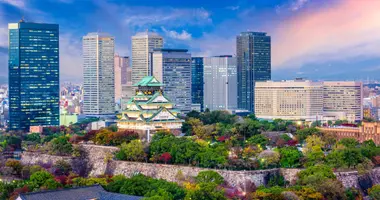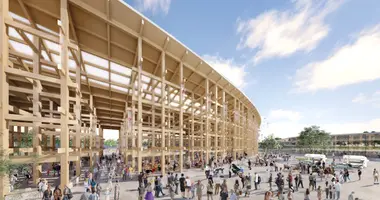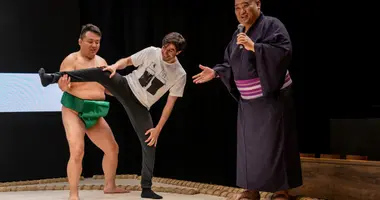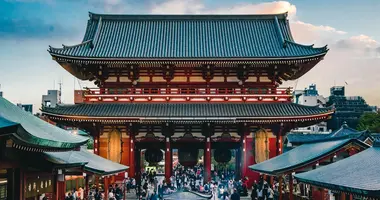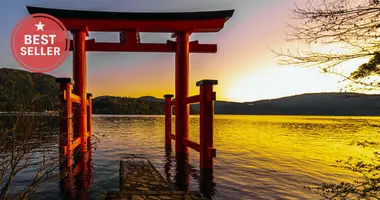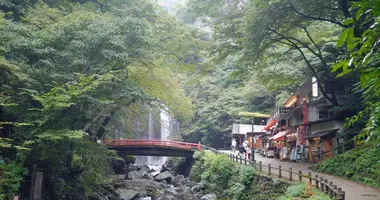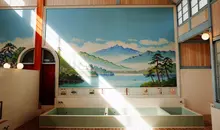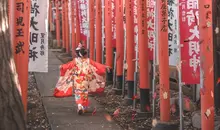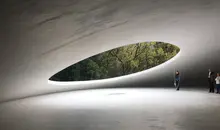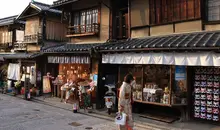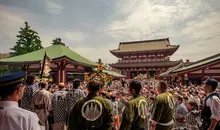Japanese Garden at Osaka Expo Park: A Tranquil Oasis in Osaka's Historic Park
- Published on : 09/03/2025
- by : Japan Experience
- Youtube
Nestled within the expansive grounds of the Osaka Expo Park, the Japanese Garden stands as a remarkable showcase of traditional Japanese landscaping spanning a millennium of design evolution. Created for the 1970 World Exposition, this 64-acre garden introduces visitors to the different styles of garden that have flourished throughout Japanese history. Unlike many gardens in Japan that focus on a single historical period, this comprehensive garden flows through four distinct styles—Ancient, Medieval, Early Modern, and Modern—offering both novice and experienced garden enthusiasts a unique opportunity to experience the entire evolution of Japanese garden design in one magnificent setting.
History and significance of the Japanese Garden at Expo '70 Commemorative Park
The Japanese Garden at Expo Memorial Park was originally constructed as part of the Japanese Government's exhibit for the World Expo of 1970, the first World's Fair held in Asia. This groundbreaking event, which attracted over 64 million visitors during its six-month run, was themed "Progress and Harmony for Mankind" and helped relaunch Japan as an advanced technological leader on the global stage.
Designed by the talented Taji Rokuro, who was also responsible for Osaka Castle Park, the garden was created with the explicit purpose of introducing international visitors to the rich tradition of Japanese landscape architecture. Following the conclusion of the Expo, rather than being dismantled like many of the pavilions, the garden was preserved as a cultural legacy within what became the Expo '70 Commemorative Park.
What makes this garden particularly significant is its educational approach to displaying the historical progression of Japanese garden design. The garden measures approximately 1,300 meters from east to west and 200 meters from north to south, covering a total of 26 hectares (64 acres). This expansive layout allows visitors to physically journey through the evolution of Japanese garden aesthetics, starting from the west and moving eastward along a flowing stream that symbolizes the passage of time through four major periods of Japanese garden history.
Today, less than 50 years after its creation, the garden has matured beautifully, with trees and plantings now fully developed, offering an authentic experience that rivals much older historic gardens throughout Japan. It stands as a testament to the foresight of its creators and continues to fulfill its original mission of cultural education through immersive landscape design.
Design features and landscaping techniques of the Japanese Garden
Ancient Garden (Heian Period, 794-1185)
The garden journey begins with the Ancient Garden style from the Heian Period, when garden design in Japan was heavily influenced by Chinese aesthetics. This section features a natural spring that serves as the water source for the entire garden, symbolizing the origin point for both water and time.
Characteristic elements include:
- Standing stones (tateishi) strategically placed to represent mountains
- Ripple-shaped sand formations (suhama) that represent beaches
- A naturalistic water source with jagged rocks
- Open, flowing water courses that reflect the aristocratic aesthetic of the Heian Period
This style can also be seen in famous gardens such as Byodo-in in Uji and Shinsen-en in Kyoto.
Medieval Garden (Kamakura and Muromachi Periods, 12th-16th centuries)
Moving eastward, the garden transitions into the Medieval style representing the Kamakura and Muromachi periods. This era was profoundly influenced by the introduction of Zen Buddhism to Japan, which revolutionized garden design.
Key features include:
- Karesansui (dry landscape gardens) where raked sand or gravel represents water
- More abstract and minimalist design principles
- Integration of tea culture with tea houses incorporated into the garden landscape
- Careful stone arrangements with deep symbolic meanings
This style is exemplified by the world-famous garden at Ryoan-ji and various sub-temples of Daitokuji in Kyoto. In the Expo garden, visitors can cross a bridge over a magnificent karesansui garden that demonstrates the sophisticated abstraction characteristic of this period.
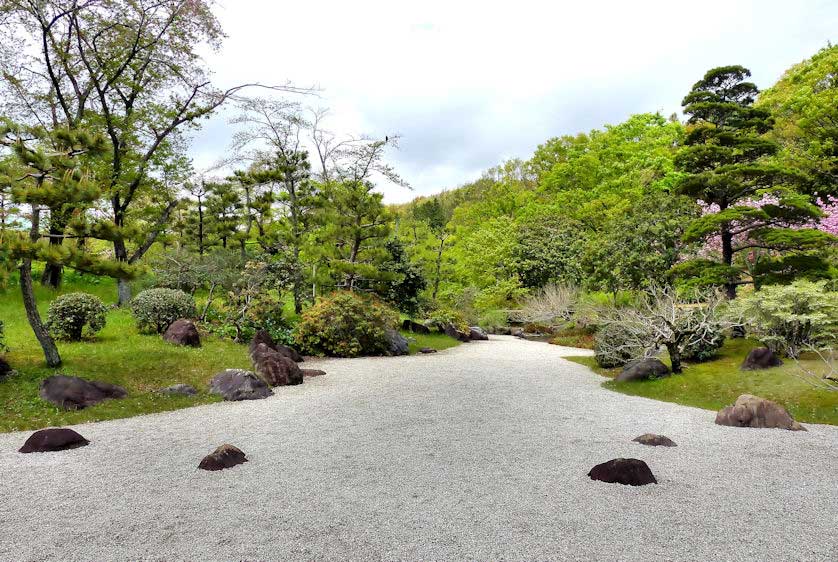
Medieval style garden, Japanese Garden, Expo Park
Early Modern Garden (Edo Period, 17th-19th centuries)
The third section showcases the Early Modern style of the Edo Period, featuring the Chisen Kaiyushiki (strolling garden around a pond) style. During this period, many daimyo (feudal lords) built expansive gardens adjacent to their castle residences.
Notable elements include:
- Shinji-ike, the large central pond shaped like the kanji character for "heart" (心, shin)
- Carefully designed pathways that reveal different views as visitors stroll around the pond
- Borrowed scenery techniques that incorporate distant views into the garden composition
- Islands within the pond that represent mythological locations or abstract concepts
- Integration of elements from earlier garden styles in a more expansive setting
Famous examples of this style include Koraku-en in Okayama City and Kenroku-en in Kanazawa.
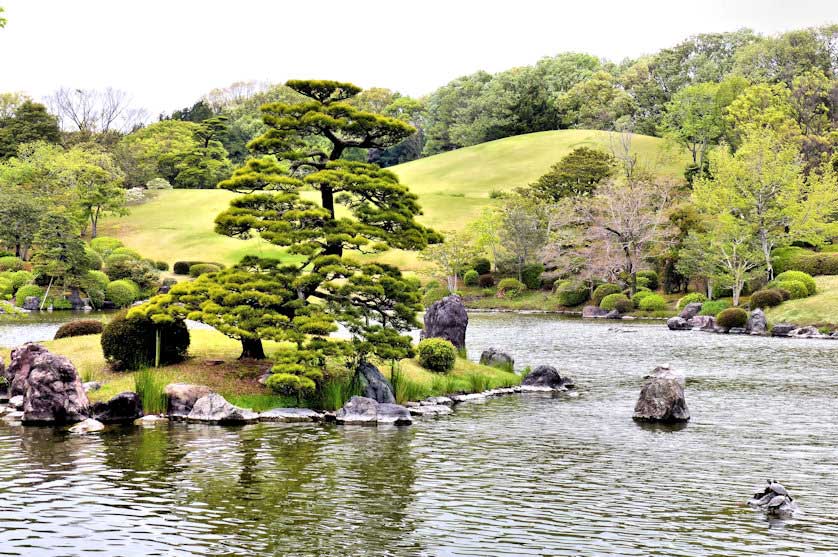
Island in Shinji Pond of the Early Modern style garden at Expo Park
Modern Garden (20th century onwards)
The journey concludes with the Modern Garden style, a 20th-century creation influenced by Western formal gardens. This section marks a significant departure from traditional Japanese garden philosophy.
Distinctive characteristics include:
- More abstract design concepts where gardens reference themselves rather than natural landscapes
- The Koi-ike Pond featuring creative arrangements of cut stones
- Approximately 60 colorful nishikigoi (koi carp) swimming in the pond
- Contemporary interpretations of traditional elements
- Greater emphasis on aesthetic novelty rather than symbolic meaning
Throughout all four sections, the garden employs the concept of "wabi-sabi" (the beauty of imperfection and transience) and showcases the Japanese aesthetic principle of elegant simplicity.
Seasonal highlights and best times to visit the Japanese Garden
The Japanese Garden at Expo Park is a year-round destination, with each season offering its own unique charm and beauty. Understanding the seasonal highlights can help you plan your visit for maximum enjoyment.
Spring (March-May)
Spring is perhaps the most celebrated season in Japanese gardens, and the Expo Park garden is no exception:
- Early March brings plum blossoms (ume), with their delicate fragrance and subtle beauty
- Late March to early April features spectacular cherry blossoms (sakura), including yaezakura varieties that bloom slightly later than standard cherry trees
- April brings fresh greenery throughout the garden, creating a vibrant atmosphere
- May offers azaleas, rhododendrons, and the first iris blooms
Spring is the busiest season for the garden, particularly during cherry blossom season, so visiting on weekdays or early in the morning is advisable.
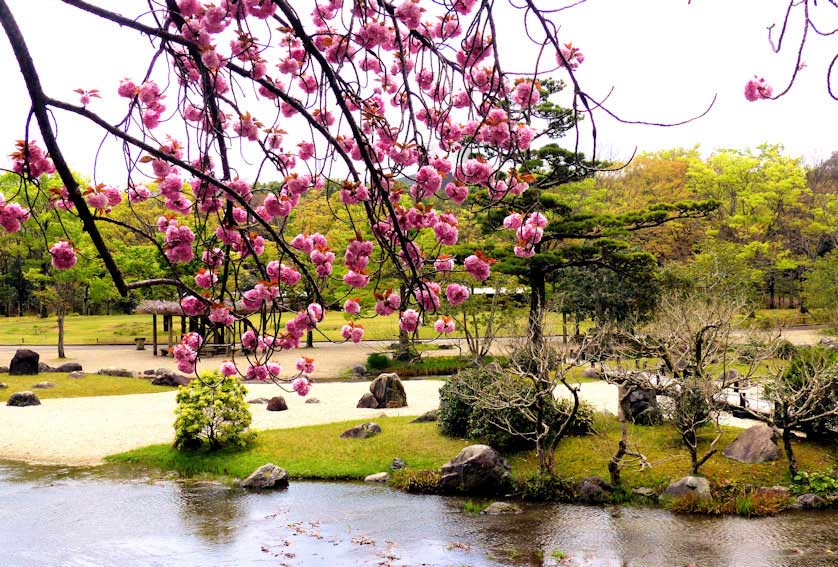
Yaezakura cherry blossoms at the Japanese garden in Expo Park, Osaka
Summer (June-August)
Summer brings lush greenery and water-loving plants to prominence:
- June features hydrangeas in various shades
- July and August highlight the lotus and water lily blooms in the ponds
- The "Early Morning Lotus Viewing" special event allows visitors to see lotus flowers when they're most open
- Summer foliage provides welcome shade for strolling the garden paths
Early morning visits are recommended during summer to avoid the midday heat and humidity, and to catch the lotus flowers at their best before they close in the afternoon sun.
Autumn (September-November)
Autumn is arguably the second most popular season for Japanese garden appreciation:
- Late October through November is the prime maple viewing period (momijigari) when the garden's maple trees turn vibrant shades of red, orange, and gold
- The special autumn festival in November allows access to normally restricted tea house areas
- The two smaller tea houses, typically closed throughout the year, open during November for the autumn festival
- Fall colors are reflected beautifully in the still waters of the garden ponds
Weekends during peak autumn colors can be crowded, but the expansive size of the garden helps disperse visitors.
Winter (December-February)
Winter offers a more contemplative garden experience:
- The garden's structural elements become more prominent without foliage
- Black pine trees, carefully maintained by traditional pruning techniques, stand out dramatically against winter skies
- Occasional snowfall transforms the garden into a monochromatic landscape of exceptional beauty
- Fewer visitors mean a more peaceful experience
The garden is closed from December 27th to January 7th for the New Year holiday period.
For photography enthusiasts, the early morning light offers the best conditions throughout the year, particularly for capturing reflections on the pond surfaces. The gardens are generally less crowded on weekdays and during the winter season, providing a more serene experience.
How to access the Japanese Garden within the larger Expo Park complex
The Japanese Garden is located within the sprawling Expo '70 Commemorative Park in the northern part of Osaka. Here's how to access it efficiently:
Access to Expo '70 Commemorative Park
By monorail (most convenient method):
- Take the Osaka Monorail to Bampakukinenkoen Station or Koen-higashiguchi Station
- From either station, it's approximately a 15-minute walk to the Japanese Garden
- To reach the monorail line from central Osaka, take the Midosuji Subway Line to Senri-Chuo Station and transfer to the monorail
By bus:
- Hankyu Bus #112 from Hankyu Ibaraki-shi Station runs on weekends and public holidays to Nihon Teien Mae bus stop
- From Nihon Teien Mae, it's a 15-minute walk to the park
By car:
- Approximately 5 minutes' drive from the Suita IC on the Meishin Expressway
- Parking is available but can be limited during peak seasons
Finding the Japanese Garden within the Park
Once inside the Expo Park:
- The Japanese Garden is located in the northern part of the park
- Follow signs for "日本庭園" (Nihon Teien) or "Japanese Garden"
- The Natural and Cultural Gardens and the Japanese Garden share a common entrance and ticket
- Pick up an English-language pamphlet at the entrance for a detailed map and garden explanations
Opening Hours and Admission
Hours:
- Open from 9:30 am to 5:00 pm (last entry at 4:30 pm)
- Closed on Wednesdays (or the following day if Wednesday is a National Holiday)
- Closed during the New Year period (December 27th to January 7th)
Admission fees:
- Adults: 260 yen
- Children (elementary and junior high school): 80 yen
- The ticket includes entry to both the Natural and Cultural Gardens and the Japanese Garden
For tea ceremony at the main tea house:
- 500 yen per person for matcha tea service
- The larger tea house, Senri-an, is open all year round
- The two smaller tea houses only open in November during the maple viewing period
Other attractions at Expo '70 Commemorative Park worth exploring
The Expo '70 Commemorative Park encompasses far more than just the Japanese Garden. While the garden is a highlight, visitors should consider exploring these other noteworthy attractions within the park complex:
Tower of the Sun
The most iconic symbol of the 1970 Expo is the Tower of the Sun (太陽の塔, Taiyō no Tō), a 70-meter high artistic structure designed by renowned artist Taro Okamoto. The tower features three distinct faces representing the past, present, and future. Since 2018, the interior has been reopened after restoration, allowing visitors to see the "Tree of Life" exhibit inside. Note that entry to the tower's interior requires advance reservations.
Natural and Cultural Gardens
Covering approximately 99 hectares, these gardens were created on the former site of the Expo pavilions. Features include:
- "Sorado" - a 300-meter elevated wooden walkway through the treetops offering unique perspectives of the forest
- Forest Foot Bath that uses biomass energy from the park's thinned wood
- Dream Pond - the largest pond in the gardens where visitors can rent pedal boats shaped like whales and swans
- Seasonal flower displays including cherry blossoms, tulips, poppies, roses, and autumn leaves

Bridge over the karesansui garden at the Japanese garden in Expo Park, Osaka
Museums and Cultural Facilities
Several museums within the park offer insights into Japanese and world cultures:
- Expo '70 Pavilion - A memorial museum housed in the renovated Steel Pavilion from the original Expo, displaying approximately 3,000 photos, videos, and other important materials from the 1970 World Exposition
- National Museum of Ethnology (Minpaku) - An extensive museum showcasing cultures from around the world with exhibitions divided into nine regional sections and thematic displays on language, music, and other cultural elements
- Japan Folk Crafts Museum, Osaka - Featuring traditional Japanese and international crafts including ceramics, textiles, paintings, and lacquerware
EXPOCITY
Adjacent to the park is EXPOCITY, a large commercial and entertainment complex opened in 2015. It includes:
- Lalaport EXPOCITY shopping mall with over 300 shops
- Japan's largest Ferris wheel
- Nifrel aquarium with innovative, art-like displays
- Various restaurants and entertainment facilities
Recreational Facilities
Active visitors can enjoy various recreational opportunities:
- Expo Tennis Garden with 36 courts (32 outdoor and 4 indoor)
- Nordic Walking Course, the first officially recognized course in Asia
- Park Golf at Expo Park, offering a simplified version of golf with shorter distances
- Genki Onsen "Expo Oyuba," a natural hot spring facility with various baths and saunas
With such diversity of attractions, visitors can easily spend a full day or more exploring the entire Expo Park complex, making it an ideal destination for families, nature lovers, and cultural enthusiasts alike.
Practical visitor information and tips for enjoying the Japanese Garden
To make the most of your visit to the Japanese Garden at Expo Park, consider these practical tips and recommendations:
Best Times to Visit
- Time of day: Early morning (9:30-11:00 am) offers the best light for photography and fewer crowds
- Weekdays are generally less crowded than weekends and holidays
- Seasonal planning: Visit during cherry blossom season (late March-early April) or autumn foliage (November) for spectacular colors, but expect more visitors
- Avoid Wednesdays as the garden is closed (unless it's a public holiday)
What to Bring
- Comfortable walking shoes as you'll be covering significant distances
- Water bottle, especially during summer months
- Camera with extra batteries and memory cards
- Sunscreen and a hat in summer, or warm layers in winter
- A small umbrella or rain jacket in case of sudden showers
Garden Etiquette
- Stay on designated paths and respect barrier ropes
- Speak quietly to maintain the peaceful atmosphere
- Do not pick flowers, leaves, or stones
- If visiting tea houses, remove shoes before entering
- Ask permission before photographing other visitors
Tea Ceremony Experience
- The main tea house, Senri-an, offers matcha tea service year-round for 500 yen per person
- No reservations are required, but be prepared to wait during busy periods
- Basic tea ceremony etiquette includes receiving the tea with your right hand while supporting the bowl with your left
- Turn the bowl clockwise two to three times before drinking
- The traditional sweet served before the tea helps balance the bitter matcha flavor
Navigation and Guides
- Pick up an English-language pamphlet at the entrance for a detailed map and explanations of garden features
- Allow at least 90 minutes to fully explore the Japanese Garden
- Consider following the chronological flow from west to east to experience the historical progression of garden styles
- Key photo spots include the view from the central rest house overlooking Shinji Pond and the bridge over the karesansui garden
Facilities
- Restrooms are available at the garden entrance and near the central rest house
- There is a rest area with benches in the center of the garden
- Limited food options exist within the garden itself, so consider bringing light snacks or planning to eat at restaurants elsewhere in the Expo Park complex
- Accessible paths are available for visitors with mobility challenges, though some garden areas have steps or uneven surfaces
By following these practical tips, you'll be able to fully appreciate the beauty and cultural significance of the Japanese Garden while enjoying a comfortable and rewarding visit.
The Japanese Garden's role in preserving traditional Japanese landscaping heritage
The Japanese Garden at Osaka Expo Park serves a crucial role in preserving and transmitting Japan's landscape design heritage, functioning as both a living museum and an educational resource. Its significance extends far beyond aesthetic enjoyment, encompassing several important cultural functions:
Documentation of Historical Garden Styles
Unlike most traditional gardens that represent a single historical period, the Expo Park garden comprehensively documents the entire evolution of Japanese garden design across multiple eras. This makes it an invaluable resource for understanding how garden aesthetics have transformed in response to changing cultural, religious, and political influences throughout Japanese history.
Each section of the garden faithfully reproduces the design principles, plant selections, and spatial arrangements characteristic of its respective period, creating a three-dimensional timeline of Japanese landscape architecture. For scholars, students, and enthusiasts of Japanese gardens, this sequential presentation offers unique insights that would otherwise require visiting dozens of separate historical sites across Japan.
Preservation of Traditional Techniques
The garden serves as a repository of traditional Japanese landscaping techniques that might otherwise fade away in our modern era. These include:
- Stone arrangement (ishigumi) methodologies that follow precise philosophical principles
- Traditional pruning techniques for pine trees and shrubs, including the labor-intensive methods used on the garden's black pines
- Moss cultivation and maintenance practices
- Water management systems that create natural-appearing water features
- Traditional carpentry methods used in the construction and maintenance of tea houses and garden structures
Master gardeners work year-round to maintain these elements using traditional tools and techniques, ensuring that these practices continue to be passed down to younger generations of landscape professionals.
Cultural Education
For Japanese citizens and international visitors alike, the garden functions as an accessible introduction to the philosophical and aesthetic principles that underpin Japanese garden design. Through its careful layout and informative materials, visitors learn about concepts such as:
- The symbolism of natural elements in Japanese landscape design
- The influence of Shinto, Buddhism, and particularly Zen on garden aesthetics
- The principle of "borrowed scenery" (shakkei) that incorporates distant views into the garden composition
- The concept of wabi-sabi that finds beauty in imperfection and transience
- The relationship between tea ceremony culture and garden design
By making these complex concepts accessible through direct experience, the garden plays a vital role in ensuring their continued appreciation and understanding.
Contemporary Relevance
Perhaps most importantly, the Japanese Garden at Expo Park demonstrates how traditional landscape design principles remain relevant in contemporary contexts. The Modern Garden section, in particular, shows how traditional elements can be reinterpreted for current sensibilities without losing their essential character.
As urbanization continues to limit green spaces in Japanese cities, the garden serves as a reminder of the importance of creating harmonious relationships between humans and nature—a core principle of Japanese garden philosophy that has renewed significance in our environmental crisis.
By preserving these traditions while simultaneously demonstrating their continued evolution, the Japanese Garden at Osaka Expo Park ensures that this invaluable cultural heritage remains alive, accessible, and meaningful for future generations. It stands not as a static monument to the past, but as a dynamic cultural resource that continues to inspire and educate in the present day.
For anyone interested in deepening their understanding of Japanese gardens beyond this experience, the garden shop offers several books on Japanese culture and garden design that provide further context and insights into this rich tradition.




